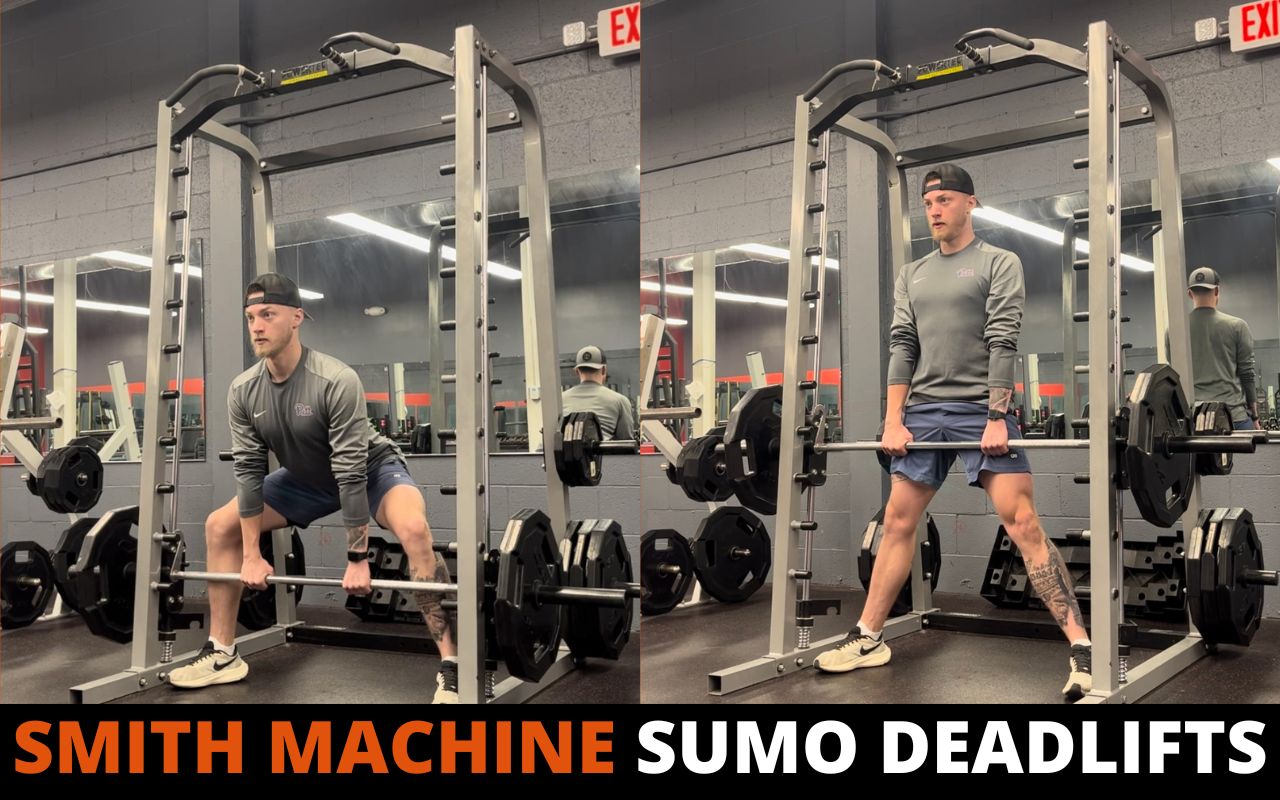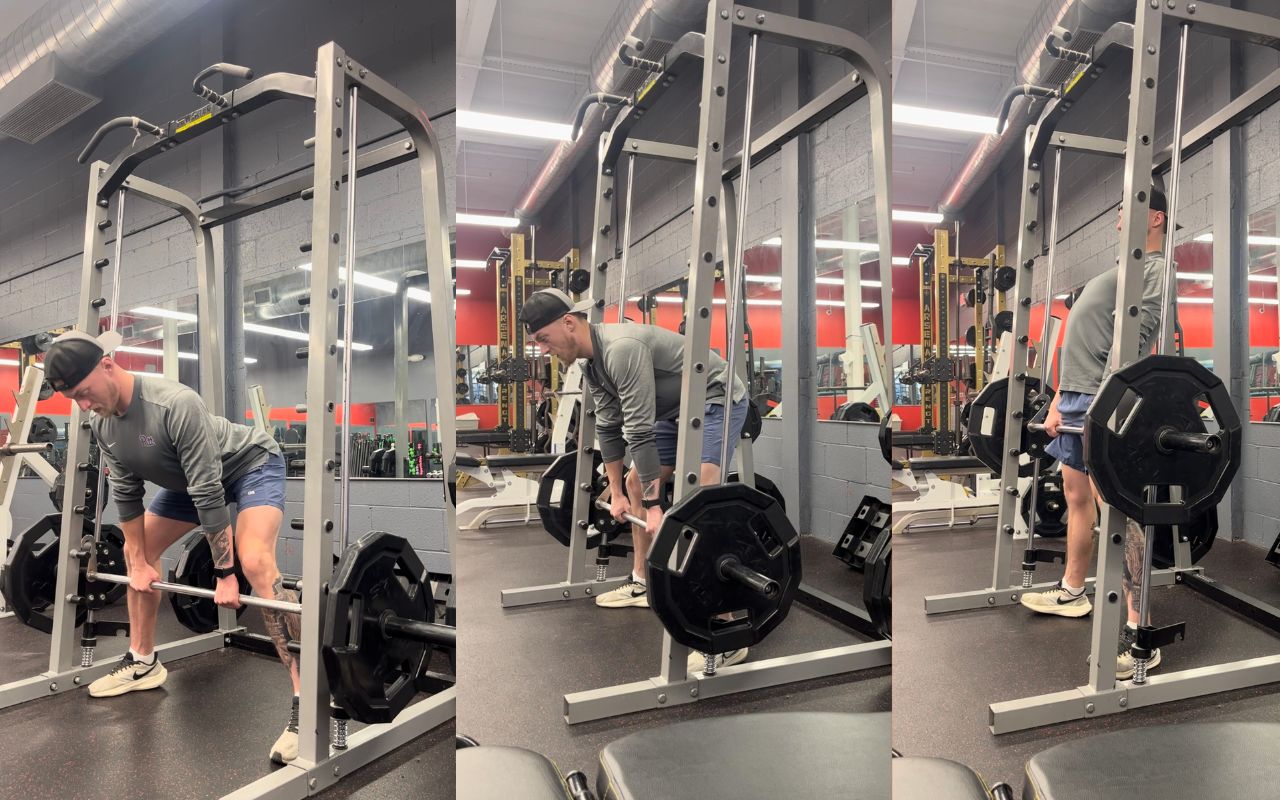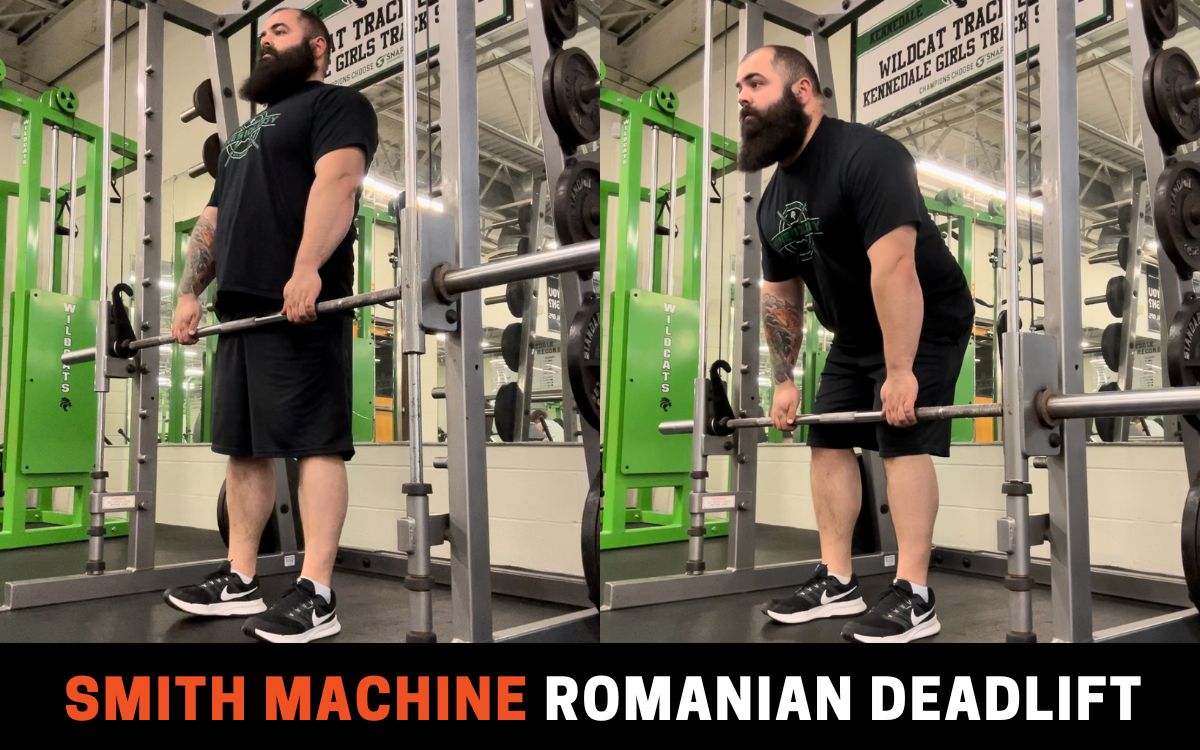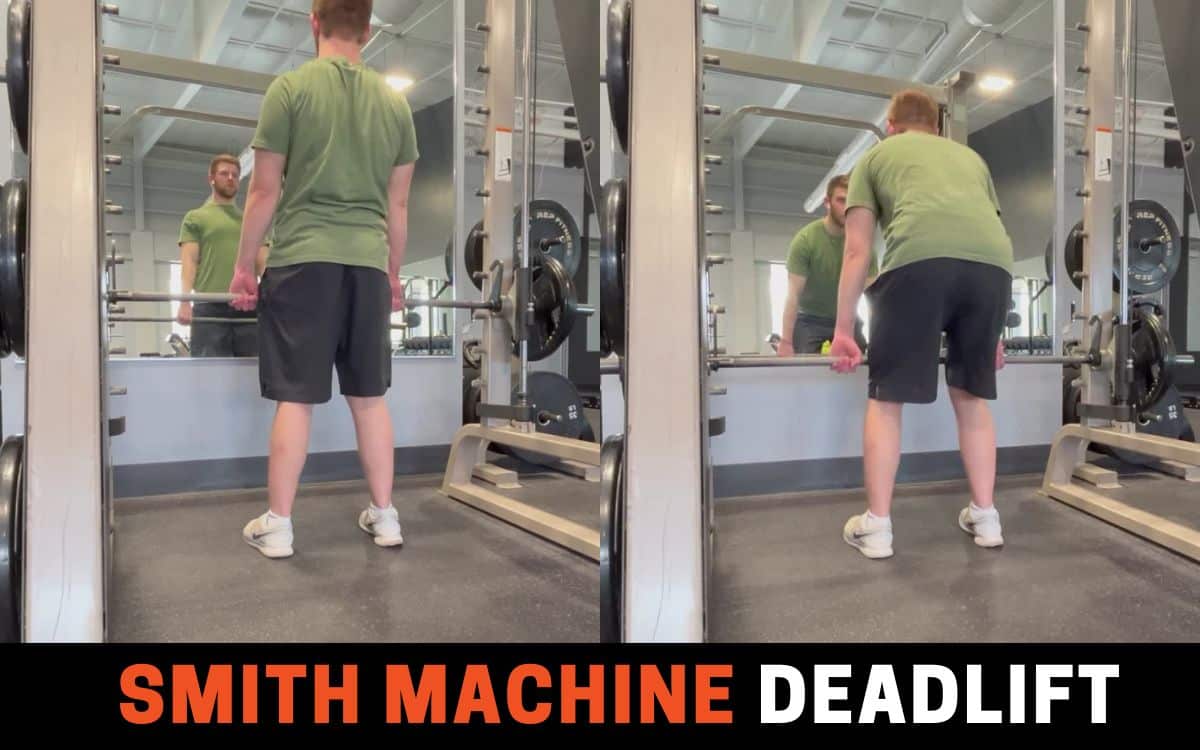A sumo deadlift has a wider stance than the conventional deadlift, isolating the quads more. Overall, it's a compound movement that strengthens the entire posterior chain with only one movement.
The Smith machine is a great tool for sumo deadlifts, especially for beginner lifters who need some form of assistance or are apprehensive about doing a conventional deadlift with a barbell.
Read on as I share how I’d show clients how to correctly do the Smith Machine sumo deadlift, common mistakes to avoid, and how to add them to your workout.
For more back exercises with a Smith machine, check out the full post.
How To Do Smith Machine Sumo Deadlift
The proper form to do a sumo deadlift on a Smith machine is as follows:
- Start facing the bar on the ground, feet just wider than shoulder-width apart. Position your hands on the bar so you can touch the inside of your knees with your elbows
- Hinge at the hips so your hips are just above the height of your knees and your chest is over the bar
- While maintaining the same depth at your hips, slowly rock backward a bit so your chest is now facing forward and shins are vertical
- Drive your feet into the floor as your chest and hips rise together. Keep your chest in the same plane during the entire lift and shoulder blades tucked back
- Keep the bar tight to your shins and thighs as you pull upward and stand up
- Pull the glutes forward so you get a full lockout at the top
- Hinge at the hips as you lower the weight to the start
Pro Tip: Imagine a glass frame in front of your torso during the movement. Keep your chest tall, and don’t break the glass as you vertically stand up
Check out how sumo deadlifts compare with conventional deadlifts in the full post.
Common Mistakes During Smith Machine Sumo Deadlifts
The most common mistakes I see as a coach during Smith machine sumo deadlifts are:
- Hips Rising Too Fast
- Spine Not Neutral
- Hyperextend Low Back To Lockout
Most beginner and novice lifters will let their hips rise too fast while their chest falls forward during the first pull off the floor. This positional fault will make the lift much more difficult to complete because the moment arm acting on the lower back is now increased in length (fun physics stuff here 🙂).
Basically, when the hips rise too fast, you will be using your weaker and injury-prone lower back muscles to do the lift instead of the stronger lower body muscles.
The spine should remain neutral during the entire rep. That means keeping your back flat, not rounding forward. The glass frame cue I mentioned seemed to work with my clients to ensure their back is flat and chest is tall with every rep.
Beginner and novice lifters often use their lower back and hyperextend during the top lockout to avoid using their glutes. The lockout should be glute-dependent, while the low back maintains the neutral spine.
Wondering how much the Smith Machine bar weighs at your gym? Check out my breakdown of the 13 most popular brands.
How To Add Smith Machine Sumo Deadlifts To Your Workout
Sumo deadlifts can be used for different goals you may have.
Increase Muscle Size
- If your goal is to increase muscle mass and size, hypertrophy training is your answer
- The American College of Sports Medicine (ACSM) recommends doing 3-6 sets of 8-12 reps with 70-85% 1RM
Increase Strength
- If your goal is to increase muscle strength, training to increase power is your answer
- I recommend doing 3-5 sets of 1-5 reps with 80-100% 1RM
You could also add other Smith machine back exercises like the shrug, row, inverted row, and single arm row.
Muscles Worked During Smith Machine Sumo Deadlift
The sumo deadlift is a full body compound exercise. The muscles used during this lift can be divided into primary and secondary muscles.
The primary muscles worked in a sumo deadlift are:
- Glutes: The glutes are responsible for hip extension at the top lockout. They pull the hips forward and protect your lower back.
- Hamstrings: The hamstrings assist in hip extension, especially during the initial pull off the floor.
- Erector Spinae: The spinal erectors are the main low back muscles that keep the spine strong and stable during the entire lift.
- Quads: The quadriceps help extend and straighten the knee. They are important during the starting position on the floor as that is where you are in the deepest knee flexion.
The secondary muscles worked in a sumo deadlift are:
- Adductors: The inner thigh adductor muscles are engaged during sumo deadlifts because of the wide stance. They help stabilize the hip joint and assist the hamstrings in hip extension.
- Lats: The lats are an upper body muscle that keeps tension through the bar tight to your body. These upper body stabilizers help maintain posture along with the erector spinae.
Does the sumo deadlift work different muscles? One study found that the quadriceps and calves were more activated during a sumo stance compared to the traditional one.
Alternatives To Smith Machine Sumo Deadlifts
When looking for alternatives, we picked variations with similar biomechanics and target similar muscles. Two alternative exercises I recommend are the Smith Machine Romanian Deadlift and the Conventional Smith Machine Deadlift.
Smith Machine Romanian Deadlift (RDL)
The Smith machine RDL is a good variation to the sumo deadlift because the two movements are pretty similar in mechanics. Both movements involve a lower body hinge and emphasize hip extension at the top. Both exercises involve the same muscles too.
Stand with your feet hip-width apart and the bar at your waist. With a little knee bend, hinge at the hips while maintaining a neutral spine so the bar finishes between your knees and mid-shin. Pull your hips forward and squeeze your glutes to return to the starting position.
Conventional Smith Machine Deadlift
The conventional deadlift also focuses on the posterior chain muscles, although there is a bit more emphasis on the lower back muscles during a conventional deadlift. Both deadlift variations require a hinge and neutral spine to effectively target the intended muscles.
Standing with your feet hip-width apart and holding onto the bar with a double-overhand grip just outside your legs. Hinge at the hips and sit them low so your chest is over the barbell. Take the tension out of the bar, drive your heels into the floor, and let your hips and chest rise simultaneously to lockout at the top.
Frequently Asked Questions
Can You Lift Heavier With Sumo Deadlift?
Most people can lift heavier with a wider stance sumo deadlift than with traditional deadlifts. That is because there is a shorter range of motion with sumo, so the barbell has to travel a shorter distance, which allows for a heavier weight.
How Many Times A Week Should You Sumo Deadlift
I recommend sumo deadlifts 1-3 times per week. That way, you allow your central nervous system and muscles to recover enough to get the benefits you were training for. Adjusting your weight, repetitions, and sets can be a good way to limit fatigue.
References
- American College of Sports Medicine. Progression Models in Resistance Training for Healthy Adults. Medicine & Science in Sports & Exercise [Internet]. 2009 Mar;41(3):687–708.
- ESCAMILLA RF, FRANCISCO AC, KAYES AV, SPEER KP, MOORMAN CT. An electromyographic analysis of sumo and conventional style deadlifts. Medicine & Science in Sports & Exercise. 2002 Apr;34(4):682–8.
- Schoenfeld BJ, Grgic J, Van Every DW, Plotkin DL. Loading Recommendations for Muscle Strength, Hypertrophy, and Local Endurance: A Re-Examination of the Repetition Continuum. Sports [Internet]. 2021 Feb 22;9(2):32.




